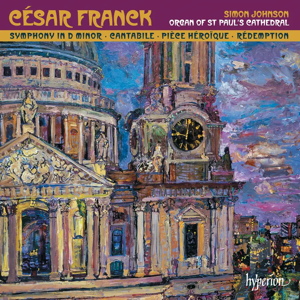
César Franck (1822-1890)
Symphony in D minor (1888, transcribed by Simon Johnson)
Trois pièces: No. 2, Cantabile (1878), No. 3, Pièce héroïque (1878)
Rédemption: Symphonic interlude (1874, transcribed by Daniel Roth)
Simon Johnson (organ)
rec. 2011, St. Paul’s Cathedral, London, UK
Hyperion CDA68046 [73]
It’s no surprise that César Franck, a professional organist, should have been “hearing” the instrument – the “blocks” of instrumental sound, the wind-string doublings, all simulating combinations of stops – as he composed the D minor Symphony. In Hyperion’s booklet note, however, I was surprised to learn that soloist Simon Johnson considers this a drawback – or, at least, that the scholars he’s quoted do so. (To be fair, he cites the shimmering tone-poem Les Éolides as having “exquisite touches of orchestration,” and I concur.) For me, Franck’s organ-mimicry, possibly best realized in the old Ormandy/Sony recording, is a highlight of the score.
Here, Mr. Johnson’s presents his take on the matter by performing the symphony in his own transcription for organ, with varied results. Where the prevailing stops are clear and “open,” the effect is wonderful. The opening of the symphony adds further dimensions of mystery to the orchestral original. The calm, quiet chorales that introduce the development evoke a magical suspension. The “pizzicatos” at the Allegretto‘s start are so convincing, I almost forgot it wasn’t the orchestra; and the recap moves along swiftly. The soloist brings off rapid passages with breathtaking virtuosity, with the hands and feet swiftly running in all directions at once.
On the other hand, the less obviously “orchestral” sounds – the “wheezing” midrange stops, or those at in-between dynamics – are a distraction when not an outright trial. At several points, sustained harmonies, while not objectively “too loud,” cut across and obscure the themes. The finale’s numerous interpolated pauses didn’t bother me: orchestral conductors use them too – though perhaps not quite so many – and they allow the generous St. Paul’s acoustic time to clear. But, from the plotzy punctuating chords near the start, where the instrument’s delayed action really interferes with the forward motion, it’s pretty much a write-off. At least the climaxes spare us the unpleasant “bulging” sound – probably a combination of bass-heavy registration and imprecise attack – that can afflict routine organ playing.
The Rédemption Symphonic Interlude, another transcription, comes off better, building its sonorities gradually from a moody, mysterious start. The faster-moving section, with its varied textures, sounds quite idiomatic, and gives Mr. Johnson the opportunity for some deft, flashy figurations. Only in the later full-organ passages does the sound again turn “heavy-bright.”
The “real” organ pieces will be an acquired taste. The Cantabile, once past its lumbering introductory chords, brings out its “singing” themes – the first plaintive, the second yearning – in sharp relief, or, rather, Mr. Johnson does with his registrations. The Pièce héroïque chugs along nicely at first, though, again, it thickens as it builds.
My judgments obviously reflect my own orchestral biases: listeners partial to the organ’s timbres and agogics may well enjoy this program more than I did. Try before you buy.
Stephen Francis Vasta
stevedisque.wordpress.com/blog
Buying this recording via a link below generates revenue for MWI, which helps the site remain free.



















